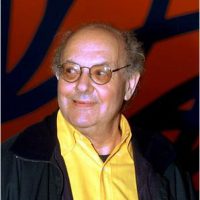

Sol LeWitt was born in Hartford, Connecticut, on September 9, 1928. As a child, he attended art classes at the Wadsworth Atheneum in Hartford. LeWitt completed a B.F.A. at Syracuse University in 1949 and then served in the United States Army in Korea and Japan during the Korean War. In 1953, he moved to New York, where he took classes at the Cartoonists and Illustrators School and did production work for Seventeen magazine. LeWitt subsequently worked in graphic design in the office of architect I. M. Pei from 1955-56. During the first half of the 1960s, LeWitt supported himself by working as a night receptionist at the Museum of Modern Art, where he met future critic Lucy Lippard and fellow artists Dan Flavin, Robert Mangold, and Robert Ryman.
In the early 1960s, LeWitt made paintings and reliefs before concentrating, in the mid-1960s, on three-dimensional works based on the cube. For these, he used precise, measured formats, such as grids and modules, and systematically developed variations. His methods were mathematically based, defined by language, or created through random processes. He took up similar approaches in works on paper.
The artist’s first solo show took place in 1965, at the John Daniels Gallery in New York. In the second half of the 1960s, LeWitt’s art was shown in group exhibitions of what would soon be known as Minimalism; among these were the 1966 exhibition “Primary Structures” at the Jewish Museum in New York. During this period, he taught at several New York schools, including New York University and the School of Visual Arts.
LeWitt is regarded as a founder of both Minimal and Conceptual art. Inspired by Eadweard Muybridge’s sequential photographs of animals and people in motion, LeWitt incorporated seriality in his work to imply the passage of time or narrative. Two important essays by LeWitt, in particular, defined the new movement: “Paragraphs on Conceptual Art” (1967) and “Sentences on Conceptual Art” (1969). The earlier text proclaimed: “The idea becomes a machine that makes the art.”
LeWitt began making wall drawings in 1968. The earliest consisted of pencil lines-in systematized arrangements of verticals, horizontals, and diagonals on a 45-degree angle-drawn directly on the walls. Later wall drawings included circles and arcs and colored pencil. LeWitt would eventually use teams of assistants to create such works. In sculpture, LeWitt mapped out all possible permutations-he found 122-of a cube with one or more sides missing in Variations of Incomplete Open Cubes (1974). From 1966, LeWitt’s interest in seriality led to his production of several artist’s books. Among them is Autobiography (1980), which documents in photographs everything in his studio on Manhattan’s Hester Street, his home for twenty years. In 1976, with Lippard and others, LeWitt founded Printed Matter, an organization established to publish and disseminate artist’s books.
In 1980, LeWitt left New York for a quieter life in Spoleto, Italy. Since the mid-1980s, he composed some of his sculptures from stacked cinder blocks, still generating variations within self-imposed restrictions. LeWitt’s wall drawings of the 1980s incorporated geometric forms and stars, as well as solid areas of ink-washed color. His wall drawing for the 1988 Venice Biennale engulfed the Italian Pavilion’s interior. In 1996, he introduced acrylics into his wall paintings, describing the colors of these paintings as “raucous and vulgar.”
Collecting since the 1960s, LeWitt and his wife, Carol, accumulated well over 8,000 artworks by his predecessors and contemporaries. The couple were generous lenders to various institutions, especially the Wadsworth Atheneum. Comprehensive LeWitt retrospectives have been organized by the Museum of Modern Art in New York (1978) and the San Francisco Museum of Modern Art (2000). After returning to the United States in the late 1980s, LeWitt made Chester, Connecticut, his primary residence. In 2000 the San Francisco Museum of Modern Art organized a retrospective of LeWitt which traveled to the Museum of Contemporary Art in Chicago and the Whitney Museum of American Art, New York.
www.guggenheimcollection.org



